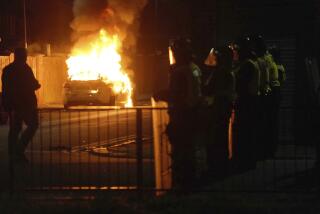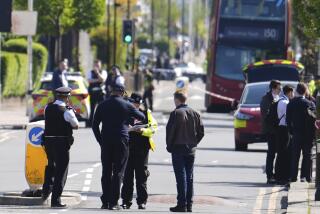A Grisly Pattern Emerges From London Nights
- Share via
LONDON — Her name was Amelie, and she’d come to London from a village north of Paris hoping to improve her English. Instead, her life came to a terrible end on a bright green cricket pitch in the nicest of middle-class neighborhoods. And she may not have been her killer’s first victim.
With the intensity of an Inspector Morse mystery, police are scouring the Thames and reenacting the crime to turn up any clue to find who bludgeoned 22-year-old Amelie Delagrange on Twickenham Green in suburban southwest London this month. The killer may be linked to a series of attacks in the area in the last 20 months.
Delagrange was killed on the night of Aug. 19 as she made her way home alone after sharing a drink with friends. She had been in Britain about two months.
The case has galvanized national newspapers -- not least because of the mystery and the possibility, not confirmed by police, that a serial killer is at large in London.
From images gleaned from London’s increasingly common security cameras, police have created a detailed timetable of her movements almost until the moment when an assailant struck her from behind with a hammer or similar blunt instrument.
“Her radiance and joy of living, described by her friends, has been brutally ended ... by the mad actions of a predator,” said a statement issued by her parents, Jean-Francois and Dominique Delagrange, appealing for any information about the crime.
Her parents knelt and prayed over the spot where Amelie was killed, leaving a stuffed Eeyore doll, her favorite. In the last 10 days, the perfect green turf where she fell has been blanketed with bouquets, notes in English and French, and mementos from Amelie’s friends and strangers alike.
The triangular patch of grass lined with tidy little houses is a typical “busy little community green,” said a 42-year-old Twickenham resident who gave her name only as Alison. Children play cricket, mothers walk with toddlers, and in the evenings patrons of the restaurant at one end sip wine outdoors 200 yards from where Delagrange was killed.
At its edges, the green is illuminated by the lights from the homes and the passing traffic, but residents say it’s deceptively dark in the middle.
A passerby found Delagrange lying on the green at 10:26 p.m., 27 minutes after she was last seen in a security camera’s video walking in the direction of her home. No witnesses to the crime have come forward, so police are using other clues to help them assemble the tale.
For one thing, there is the series of unsolved attacks in the same area since early 2003. They include the killing in February 2003 of a student, Marsha McDonnell, and an attack in April on a 34-year-old accountant, Edel Harbison, who is still recovering from her injuries. Like Delagrange, both women had short blond hair.
The first attack was in January 2003, when a 17-year-old girl was found bleeding in Strawberry Hill, a few blocks from where Delagrange and Harbison were later assaulted.
A few miles away, in the Hatton Cross area, bookkeeping clerk Dawn Brunton, 36, was attacked last November, suffering a fractured skull. She thinks she was hit with a sledgehammer and believes it must have been the same assailant as Delagrange’s. Police interviewed her again last week.
“When I heard about Amelie’s murder, I was in absolute shock,” London’s Evening Standard quoted her as saying. “There are so many similarities between what happened to me. The attacker came up behind, and the last thing I heard was the rustling of leaves before he hit me on the back of the head.
“When I think of what happened to Amelie, I’m lucky to be alive. My life was probably saved because I was discovered quite quickly by a passerby.”
A significant breakthrough came Tuesday, when Det. Chief Supt. Andy Murphy announced that Delagrange’s house keys, disc player and wallet had been recovered from the Thames River at Walton in nearby Surrey. Officials said the killer may have dumped her belongings there barely 20 minutes after the crime, driving from Twickenham in light traffic.
Although Murphy did not specify how police divers knew to search the river beneath the Walton Bridge, newspapers said signals from her cellphone had been traced. Neither the phone nor the handbag has been recovered.
On Thursday, a 29-year-old policewoman, Sarah Swift, chosen because of her resemblance to Delagrange, dressed up in clothes similar to those Delagrange was wearing when she was killed. Swift was filmed as she left the same bar, went by a 267 bus, alighted and crossed into Twickenham Green, stepping over the knee-high white railing onto the grass.
The reenactment, widely shown on television, was meant to jog the memory of anyone who could have seen something. Police said Friday that it had elicited “hundreds” of phone calls.
At the same time, detectives are poring over thousands of images gleaned from security cameras of men and women and cars in the vicinity of Twickenham Green and nearby Waltham-on-Thames before and after the killing.
Murphy, who heads the investigation, has told reporters that the killer may have been lurking in a car near Twickenham Green that night, waiting for a victim.
“It is quite possible that a vehicle was used, and certainly if Amelie was murdered around 10 p.m., somebody could have arrived here within 15 or 20 minutes,” said Murphy, speaking at the Walton Bridge site.
For the residents in the neatly hedged bungalows and Victorian houses around Twickenham Green, particularly women, the killing has shattered their feelings of safety. Many say they had passed by the green that night and noticed nothing untoward. Now women are taking taxis rather than walking and calling one another to make sure everyone got home safely.
“This is such a nice area,” said Theresa Smith, who runs a small shop next to the Strawberry Hill train station that takes commuters to central London’s Waterloo Station.
“These things don’t happen in nice areas, do they?” she said. “I suppose they do, but you don’t expect it.”
Janet Stobart of The Times’ London Bureau contributed to this report.
More to Read
Sign up for Essential California
The most important California stories and recommendations in your inbox every morning.
You may occasionally receive promotional content from the Los Angeles Times.










